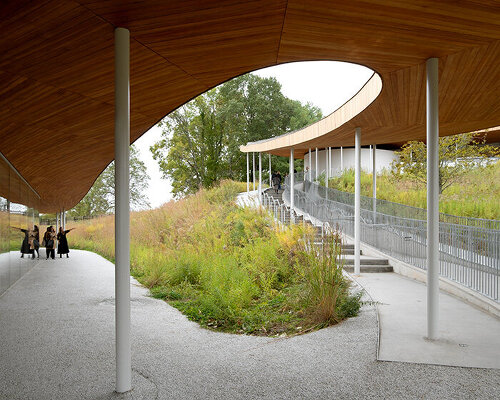a decade of grace farms
Grace Farms in New Canaan, Connecticut, has marked its tenth anniversary with a new collection of installations and programming in and around SANAA’s iconic, serpentine River Building. Designed by Kazuyo Sejima and Ryue Nishizawa, the glass-and-steel structure drifts across an 80-acre landscape of meadows and woodlands, its continuous roofline following the contours of the site like a line drawn in light. A decade on, the building feels increasingly absorbed into its setting, the distinctions between constructed and natural softened by time, weather, and use.
designboom attended the 10 Year Celebration on October 11th, 2025, and met with SANAA co-founder Kazuyo Sejima as she returned to the site. She was joined by Sharon Prince, Grace Farms’ CEO and founder, and architect Toshihiro Oki, a member of the Design for Freedom Working Group. The gathering introduced new architectural and artistic commissions — from a series of SANAA-designed benches, new artist commissions, and a new fascia for the River Building’s meandering rooftop.
Grace Farms in Connecticut celebrates ten years | image © designboom
sanaa returns to connecticut with sculptural seating
Visitors to Grace Farms are now invited to sit amongst an installation of Dancing Trees, a series of six sculptural benches by SANAA’s Kazuyo Sejima, crafted from locally sourced Connecticut black cherry. Each piece retains the gentle irregularities of the trees they were shaped from, with minimal intervention beyond the addition of slender legs. Arranged in the Plaza, they suggest informal gathering, a continuity of the River Building’s flowing social spaces in solid wood.
Sejima described the work as ‘figures dancing together,’ each with a different posture yet moving in quiet relation to one another. Visitors can sit, lean, or rest along the curved surfaces, engaging with the material’s warmth and the surrounding landscape designed by Olin Studio. For Oki, the project represents a shift in process — ‘the material itself, its location and natural growth method could help us achieve the design,’ he notes, emphasizing the dialogue between form and context.
Kazuyo Sejima, Sharon Prince, and Toshihiro Oki at the Dancing Trees | image © designboom
A New Cedar Fascia from Haida Gwaii
Subtle but significant changes to the River Building itself include a new fascia of vertically oriented timber slats wrapping its continuous profile. The Western red cedar, sourced from the Taan forest in Haida Gwaii, British Columbia, was chosen for its durability and ethical provenance.
Managed by the Haida Enterprise Corporation, the forest is stewarded entirely by the Haida Nation, aligning with Grace Farms’ Design for Freedom principles that advocate for transparency and fair labor within the global building materials supply chain.
Photographer and Grace Farms artist-in-residence James Florio documented this forest in his new work, Haida Gwaii, 2025, now permanently installed in the River Building’s Library. His photographs trace the depth and extreme verticality of cedar trunks, and connects the building’s new timber cladding to the landscape and community from which it originates.
a new series of programming and art installations is now on view | image © designboom
a new installation: ‘With Every Fiber | Pigment, Stone, Glass’
The anniversary coincided with the unveiling of a new installation of With Every Fiber | Pigment, Stone, Glass, the long-term exhibition that examines ethical sourcing in architecture and the construction industry. The exhibit — originally conceived by architect Nina Cooke John and curated by Grace Farms Founding Creative Director Chelsea Thatcher — features new commissions by artists and engineers who reinterpret the materials most implicated in forced and child labor: pigment, stone, and glass.
Among them, John Sabraw’s Lithologic uses pigments derived from the remediation of acid mine drainage, while Webb Yates Engineers’ Stone Space Frame demonstrates how post-tensioned stone might replace carbon-heavy steel trusses.
Hannah Rose Thomas’s tempera portrait of Nasreen Sheikh, a human rights activist and survivor of modern slavery, is accompanied by Woven in Tears, a composition by Evan Williams performed by the London Philharmonic Orchestra. All together, these works are a meditation on the labor embedded within materiality itself.
a new cedar fascia from the island of Haida Gwaii shows ethical material sourcing | image © designboom
ParaPosition, a new permanent sculpture by Alicja Kwade is now on view | image © designboom
Toshihiro Oki, Kazuyo Sejima, Sharon Prince, and Chelsea Thatcher | image © designboom
Grace Farms’ theater space, The Sanctuary, hosted a performance by Joshua Bell | image © designboom
Olin Studio transformed the vast farm into rolling meadows and woodlands | image © designboom
project info:
name: Grace Farms | @gracefarmsct
architect: SANAA | @sanaa_jimusho (Kazuyo Sejima + Ryue Nishizawa)
location: New Canaan, Connecticut, USA
previous coverage: October 2012, November 2014, October 2016, November 2020
photography: © designboom
The post with its iconic, serpentine architecture by SANAA, grace farms turns ten years old appeared first on designboom | architecture & design magazine.

